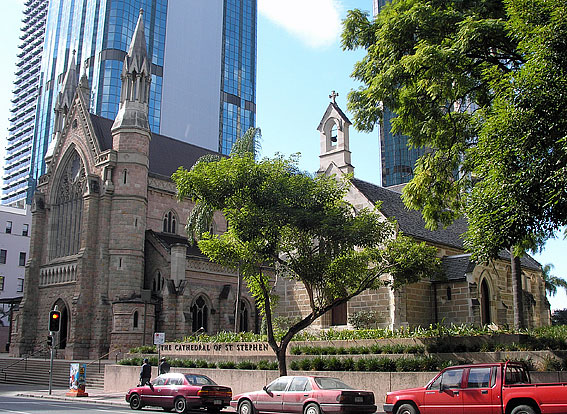
[Photograph by Simon Colvin (May 2008)]

[Photograph by Simon Colvin (May 2008)]
Historical and Technical Documentation by Geoffrey Cox1
© OHTA 2001, 2007, 2014, 2020 (last updated September 2020)
St Stephen's Cathedral was opened on 17 May 1874,2 superseding Old St Stephen's, which still stands alongside it. A Gothic Revival building built of porphyry and freestone, the new Cathedral was built in stages: The foundation stone was laid in 1863, with the intention of constructing a grand building to the design of architect Benjamin Backhouse. With the economic crisis of the 1860s, work on the building ceased in 1864, and when construction was resumed in 1870, it was to a smaller and simplified design by the Brisbane architect, R. George Suter. Two sandstone towers were added in 1884, and the sacristy and simple transepts were added in 1922.3
Archbishop James Duhig planned for a completely new Holy Name Cathedral (opposite All Hallows' Convent), for which the foundation stone was laid in September 1928, but these plans never proceeded. Instead, St Stephen's was extensively renovated in 1988-89 under the direction of Brisbane architect, Robin Gibson. At this time, three new chapels were added at the east end, the gallery was removed from the west end, and the original towers (which had already been removed) were replaced.4
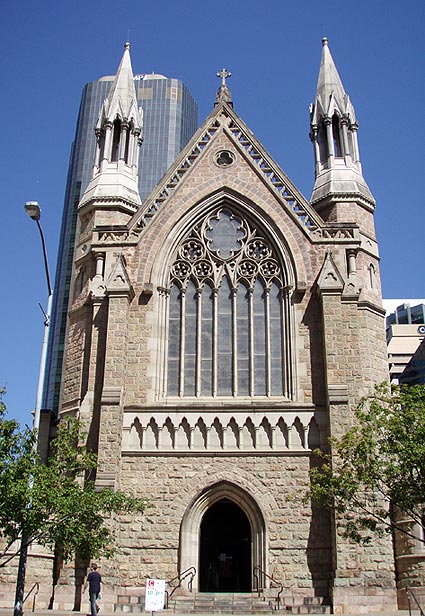
St Stephen's Cathedral, Brisbane
[Photograph by Christopher Cook (October 2007)]
First Organ.
Details of the first organ at St Stephen's are shrouded in mystery. It was brought out from Europe for the new Cathedral by the Bishop, the Right Rev. James Quinn, and initially erected in the Old St Stephen's Church, where it was tried for the first time in January 1873. It was noted that 'although it may temporarily serve the purpose, the new Cathedral, when completed, will deserve a much larger instrument.'5 Reports in February 1873 in the Melbourne and Sydney church papers described the official opening:
St. Stephen's Church
Among the various commissions executed by the Rev. Dr. Quinn, the Roman Catholic Bishop of Brisbane, was (says the Brisbane Telegraph of the 20th ult.) the purchase of a very splendid organ for St. Stephen's Church, the erection of which has just been completed by Mr. P. C. Atkinson, the organist, and for the first time was used yesterday morning, at 11 o'clock, when the Mass Mozart's in C No 1 was selected, and sung right through; the principal parts being sustained by Mrs. Atkinson and her son; they were also materially assisted by the Rev. D. Carmusci, and in the basso part by a gentleman amateur. The result was a most effective performance of this beautiful composition. The instrument contains three "manuals" and 29 notes of pedals. There are four stops on what is termed the "great" organ, four on the "swell" organ, and three on the choir organ, with couplers from each complete.6
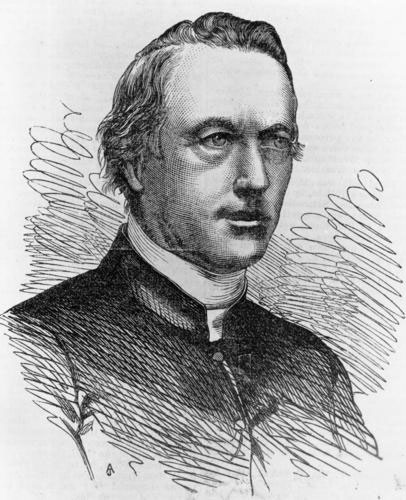
James Quinn, First Catholic Bishop of Brisbane
[Illustration: John Oxley Library, State Library of Queensland]
Quinn's organ was moved to the new Cathedral, when it was opened in May 1874.7 The temporary nature of this instrument is further confirmed by the fact that by 1896 Rev. Father Fouhy, the Administrator of the Diocese, having been entrusted to purchase a new organ for the Cathedral, was reported to have done so,8 although the report was later modified to say that 'he had made arrangements with a firm of organ builders in France to supply an organ whenever the Cathedral was so far finished as to admit of the introduction of such an organ.'9 It appears that the plans of 1896 did not bear fruit, for the following note concerning the organ of St Stephen's appeared in 1906, along with descriptions of several other organs in major Brisbane churches at the time:
Very little indeed can be said of the organ at St Stephen's Cathedral. It is not necessary to describe the instrument, because those acquainted with it know that it is quite inadequate for cathedral purposes. The organ was purchased by the late bishop, Dr. O'Quinn [sic], in 1871. Miss Nellie Starkey is the organiste, and Mr P. J. Henry acts as choirmaster.10
This description was accompanied by photographs Mr P.J. Henry (Choirmaster, St Stephen's Cathedral) and Miss Nellie Starkey (Organist St. Stephen's Cathedral), and a photograph showing a small organ of three manuals, with a drawstop console and an unusual exposed swell box flanked by diapason pipes on either side.
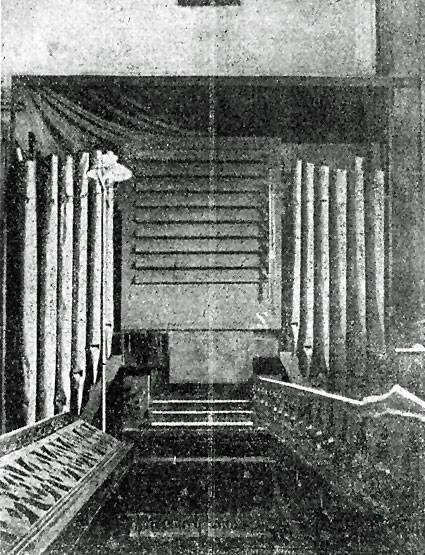
The anonymous organ of 1873 in St Stephen's Cathedral
[Photograph: The Daily Mail (10 March 1906), p. 9]
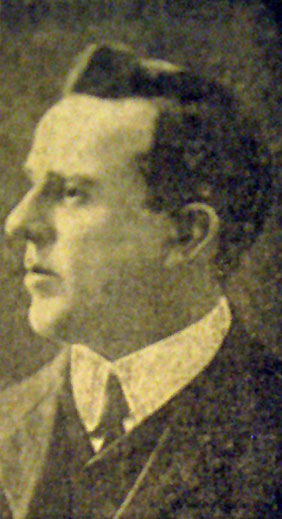
Mr P. J. Henry (Choirmaster, St Stephen's Cathedral)
[Photograph: The Daily Mail (10 March 1906), p. 9]
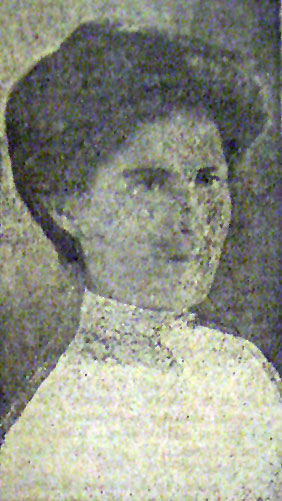
Miss Nellie Starkey (Organist, St Stephen's Cathedral)
[Photograph: The Daily Mail (10 March 1906), p. 9]
The origins of this organ, purchased by Bishop James Quinn in the early 1870s, remain obscure. Quinn's brother, Matthew, who was Bishop of Bathurst, is known to have ordered an organ around 1876 for Bathurst Catholic Cathedral from White & Son of Dublin.11 It is perhaps significant that James Quinn, who became Bishop of Brisbane in 1861, travelled abroad between 1869 and 1872 to attend the Vatican Council in Rome, and that he visited Dublin before returning to Australia.12 The organ may therefore have been of Irish origin.
There appears to be no record of it after 1906. The late Miss Kitty Slack, organist at the Cathedral (1923-1973) and a choir member before that, had no recollection of it. She recalled only a small, movable organ (apparently a reed organ from the description and size) that stood in the gallery and was pumped by hand from the side, before the installation of the second organ in 1921.13
Second Organ.
The large three-manual organ that stood in the former west gallery of the Cathedral from 1921 until the building was renovated in 1988, attributed to William Anderson of Melbourne, was purchased in 1990 by the Queensland Government for the Queensland Youth Orchestra. It was installed in 1998 in the orchestra's new home, the Old Museum Building, Bowen Hills.14
Present Organ.
The contract for the present organ in the Cathedral was signed with Knud Smenge of Melbourne in 1998.15 Described on the builder's nameplate as his Opus 50, the instrument is mounted on the east wall behind the sanctuary, so that the sound projects directly down the nave. Owing to limitations of space, the bulk of the organ is located fairly low, beneath the three east-facing lancet windows, with two tall towers flanking the sides of the windows.

[Photograph by Trevor Bunning (October 2007)]
The casework, of Tasmanian Oak, was designed by the architect, Robin Gibson. The console is movable and the action is entirely electric (including the swell mechanisms). This was unusual for Smenge, almost all of whose instruments were built using mechanical action. The consultant for the project was Dr Robert Boughen, at that time Organist of St John's Cathedral, Brisbane.
This is the second cathedral in Australia for which Knud Smenge has built an organ, the first being St George's Anglican Cathedral, Perth, for which he supplied two organs in 1993-94. The instrument at St Stephen's was Smenge's last before his retirement. It was blessed and officially opened on Sunday 29 October 2000, an organ recital having been given on the previous evening by Dr Robert Boughen.
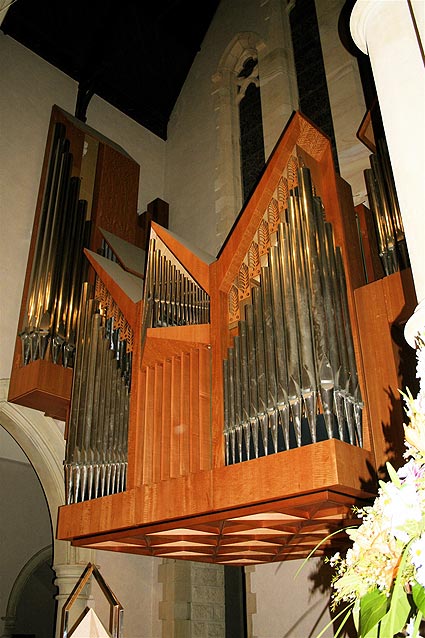
[Photograph by Trevor Bunning (October 2007)]
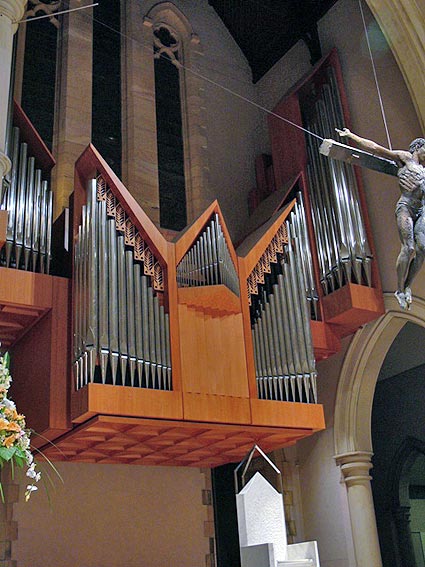
[Photograph by John Maidment (October 2007)]
The specification of the instrument is as follows:
| GREAT Bourdon Principal Rohrflute Hohlflute Gamba Salicional Octave Harmonic Flute Spitzflute Octave Mixture Trumpet SWELL Bourdon Hohlflute Salicional Voix Celeste Principal Spitzflute Nazard Waldflute Terz Mixture Fagot Harmonic Trumpet Oboe POSITIV [enclosed] Gedackt Spitzflute Rohrflute Principal Nasat Sesquialtera Clarinet Fanfare Trumpet PEDAL Untersatz Subbas Principal Bourdon Octave Spitzflute Bourdon Choral Bass Mixture Bombarde Fagot Trumpet Fagot Oboe COUPLERS Great to Pedal Swell to Pedal Positiv to Pedal Swell to Great Swell to Positiv Positiv to Great Great to Positiv Swell Sub Octave Swell Super Octave Positiv Sub Octave Positiv Super Octave |
16 8 8 8 8 8 4 4 4 2 IV-V 8 16 8 8 8 4 4 2-2/3 2 1-3/5 IV 16 8 8 8 8 4 2 1-1/3 II 8 8 32 16 16 16 8 8 8 4 IV 16 16 8 8 4 |
[from Sw] [from Sw] [from Sw] [from Sw] [from Sw] A A B [from Sw] B [from Sw] [from Sw] [from Sw] [from Sw] |
Swell tremulant
Positiv tremulant
Great tremulant
Detached (movable) console
Electro-pneumatic action
Compass: 61/32
Radiating concave pedalboard
Cone tuning
Equal temperament
8 thumb pistons to Swell Organ
8 thumb pistons to Great Organ
8 thumb pistons to Positiv Organ
8 combination pedals to Pedal Organ
8 General thumb pistions
8 General combination pedals
Sequencer
Manuals I & II invertible
Both 'swells' available on one Swell Pedal.16
Some minor tonal finishing and adjustments to the electrics of the organ were carried out in 2001 by W.J. Simon Pierce.17
Following the reroofing of the Cathedral around 2016-17, during which it appears that inadequate precautions were taken to protect the organ, the instrument was coated in fine dust and some large chunks of masonry fell. It was announced in September 2020 that the following work would be undertaken by Pierce Pipe Prgans of Brisbane:
• removal and cleaning of all pipework,
• 'judicious' tonal resetting of the Great and Swell,
• replacing some of the ailing transformer/rectifiers,
• installing a new Solid State Logic relay and capture system.18
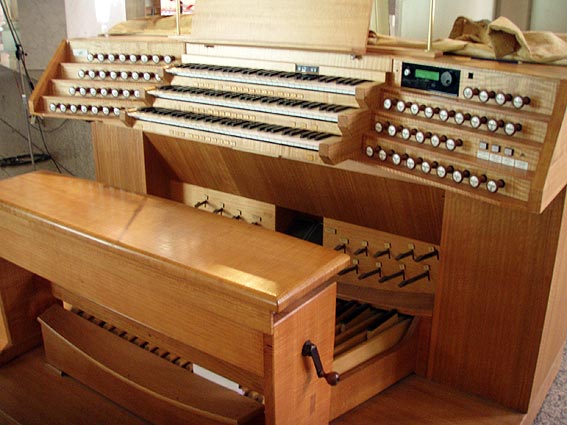
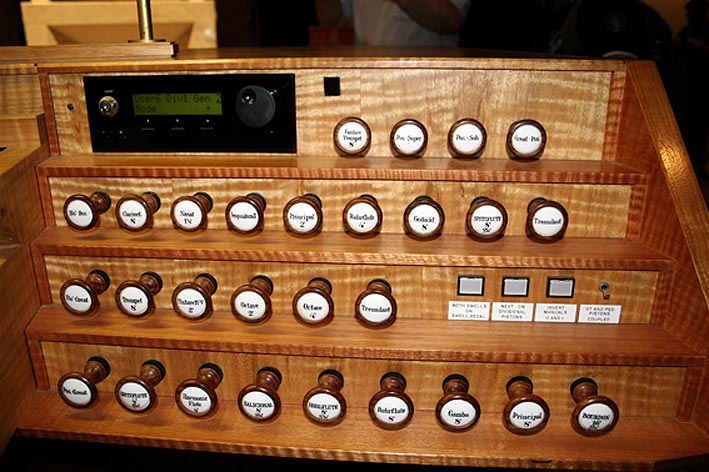
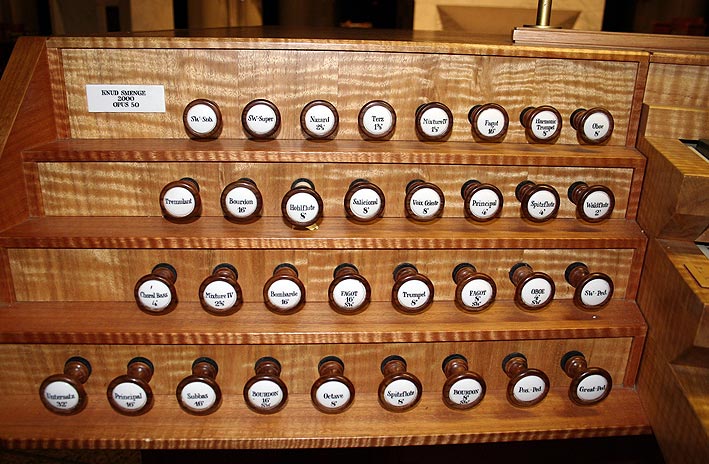
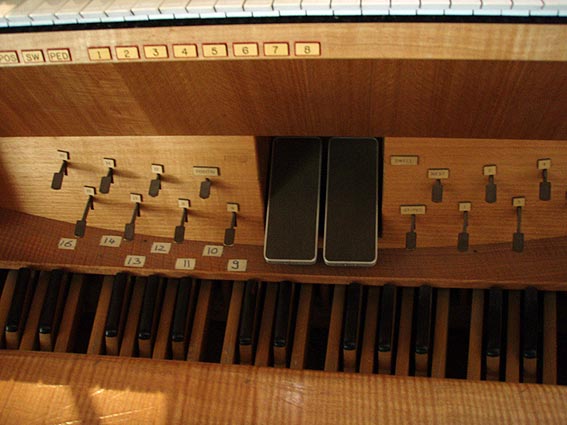
The console of the Smenge organ
[Photographs by Christopher Cook (October 2007)]

[Photograph by Trevor Bunning (October 2007)]
______________________________________________________________________________
1 An earlier version of this article appeared as 'The Organs of St Stephen's Cathedral, Brisbane, 1873-2000,' OHTA News, vol. 25, no. 1 (January 2001), pp. 12-17.
2 'Diary of Events' for 16 & 17 May 1874 in Pugh's Queensland Almanac . . . for 1875.
3 Queensland Heritage Council, Queensland Heritage Register, location 600107; The Heritage of Australia: The Illustrated Register of the National Estate (South Melbourne: Macmillan, 1981), 4/14.
4 Queensland Heritage Register, op. cit; One Voice, vol. 5, no. 1 (Pentecost 1990), pp. 30-31.
5 The Brisbane Courier (24 January 1873), p. 4, col 7.
6 The Freeman's Journal (8 February 1873), p. 6, col 2; see also: The Advocate (1 February 1873), p. 7.
7 The Brisbane Courier (16 May 1874), p. 1 - cited in Neil Byrne, 'The Music and Musicians of St Stephen's Cathedral: The First Sixty Years,' Proceedings of Brisbane Catholic Historical Society, vol. 2 (1990), pp. 15-29.
8 The Brisbane Courier (23 May 1896), p. 4.
9 The Brisbane Courier (21 December 1896), p. 4.
10 The Daily Mail (10 March 1906), p. 9.
11 Graeme Rushworth, Historic Organs of New South Wales: The Instruments, Their Makers and Players, 1791-1940 (Sydney: Hale & Iremonger, 1988), pp. 344-45.
12 Personal communication to G. Cox from Graeme Rushworth, 25 and 27 January 1989.
13 Personal communication to G. Cox from Miss Kitty Slack, September 1974.
14 The Courier Mail (29 June 1990), p. 9.
15 One Voice, vol. 13, no. 1 (Pentecost 1998), p. 21.
16 Specification noted by G. Cox, January 2001. The number of stops duplexed from the Swell to other divisions was apparently increased, and one coupler (Great to Positiv) was apparently added after the initial stop list (as supplied by Knud Smenge in September 1998) had been drawn up.
17 The Organ Voice, vol. 27, no. 2 (June 2001), p. 32.
18 "News from Organbuilders," OHTA News, vol. 45, no. 3 (September 2020), p. 4.
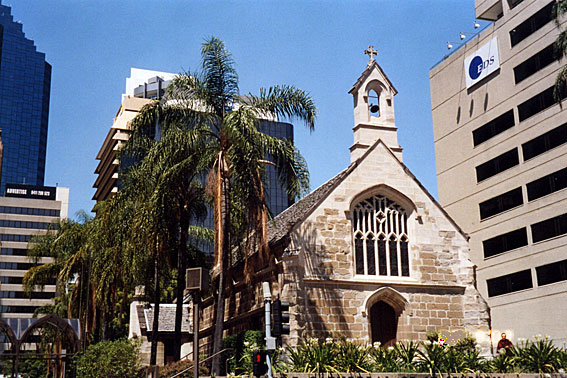
St Stephen's Old Cathedral (Pugin Chapel)
[Photograph by Geoffrey Cox (September 2007)]
Historical and Technical Documentation by Geoffrey Cox
© OHTA 2007, 2011, 2013 (last updated January 2013)
Catholicism could be said to have first reached Queensland with the visit of Archbishop John Bede Polding from Sydney in May1843, only twelve months after the colony of Moreton Bay was opened for free settlement in 1842. Mass was at first celebrated in the old Government store in Elizabeth Street.1 Old St Stephen's Cathedral was constructed between 1848 and 1850, and is the oldest surviving church building in Queensland. The first mass in the building was celebrated on 12 May 1850, and it became the Cathedral in 1859 with the appointment of Bishop James Quinn to the newly proclaimed Diocese of Brisbane.2
This simple Gothic building was built to an 1842 design supplied to Archbishop Polding by the eminent English architect, Auguste Welby Pugin.3 It was the principal Catholic church in Brisbane until the new Cathedral was opened alongside it in May 1874.4
Because of the soft sandstone used in its construction, the original belfry had crumbled away even by the late 1860s, and the building has several times been threatened with demolition. It has been used variously as a school room, church offices and for storage over the period of a more than a century, and was restored in 1995-99 as a diocesan shrine of St Mary of the Cross (MacKillop).5
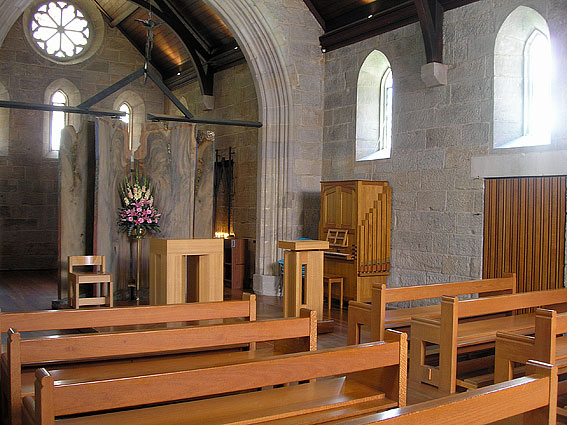
St Stephen's Old Cathedral (Pugin Chapel)
[Photograph by Simon Colvin (May 2008)]
First Organ.
A seraphine was used in this building from October 1850 onwards, by which time there was already a "very respectable and efficient choir" under the direction of Mr W.A. Duncan.6
The first pipe organ in this building was brought out from Europe by Bishop James Quinn, and first used in January 1873. It was moved to the new St Stephen's Cathedral in 1874.7
Present Organ.
The present organ in the Pugin Chapel originated as a small instrument constructed by George Fincham & Sons of Melbourne in the mid 1970s. It was one of at least four identical mobile chamber organs (on wheels) constructed by Finchams at the time. Others survive at the Charles Darwin University Performing Arts Centre, Darwin, and at the University of New South Wales Music Department, while another (originally at the Faculty of Music, University of Melbourne) is now at St Peter's Anglican Church, Eastern Hill, Melbourne. The chest and original keyboard were supplied by G. Hradetzky of Austria, while the pipework and original case were made by Finchams in Melbourne.8

Mr David Molloy at the George Fincham & Sons organ
[Photograph: The Leader (25 June 1978), p. 15]
Mr David Molloy, then organist of St Stephen's Cathedral, Brisbane, had been impressed by the organ when attending the 1978 Festival of Organ and Harpsichord in Melbourne, and was instrumental in having it brought to Brisbane and purchased by the Liturgical Commission of the Archdiocese. It was initially hired by the Institute of Pastoral Liturgy in June/July 1978 for a ten-week course on liturgy being conducted at the Augustinian House of Studies, Clayfield.9 After being housed for a short time in 1978-79 in the Pugin Chapel (Old St Stephen's Cathedral), the instrument was moved by H.W. Jarrott in May 1979 to the Institute of Pastoral Liturgy (formerly Augustinian Priory) at Clayfield. It was purchased by Pius XII Seminary, Banyo, in June 198810

[Photograph by Trevor Bunning (October 2007)]
After being extensively rebuilt by W.J. Simon Pierce of Brisbane in 1998, the instrument was returned to the Pugin Chapel at some time following the rededication of the building on 5 February 1999. The casework was completely remade in Tasmanian Oak, the soundboard reduced, and new pallets, keyboard and suspended action were fitted. All pipework was re-scaled and revoiced, and much of the 8ft and 2ft ranks were completely replaced. Indeed, relatively little of the original instrument remains, and the resulting organ is essentially the work of W.J. Simon Pierce.11
| MANUAL Stopt Diapason Rohr Flute Principal Quint |
8 4 2 1-1/3 |
[originally 'Gedeckt'] (metal) |
Compass: 54 notes
Mechanical action
No pedals.12
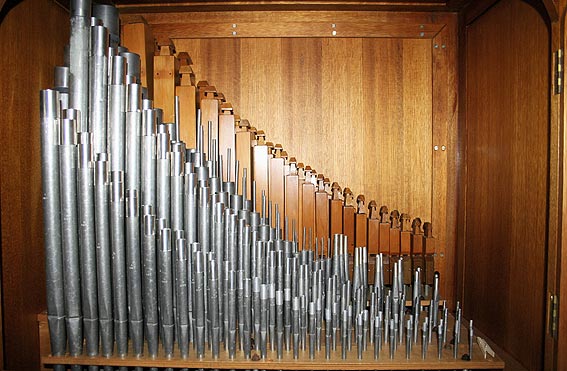
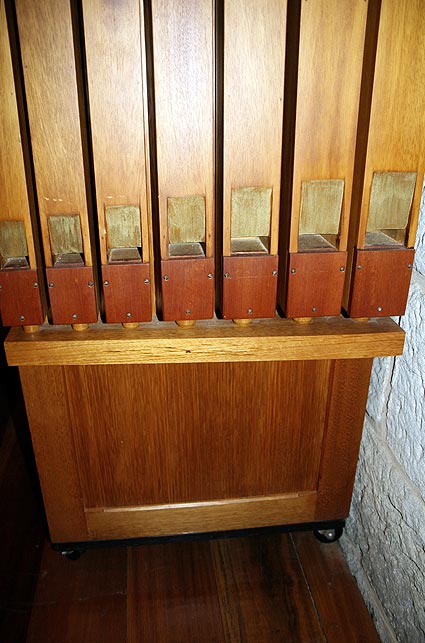
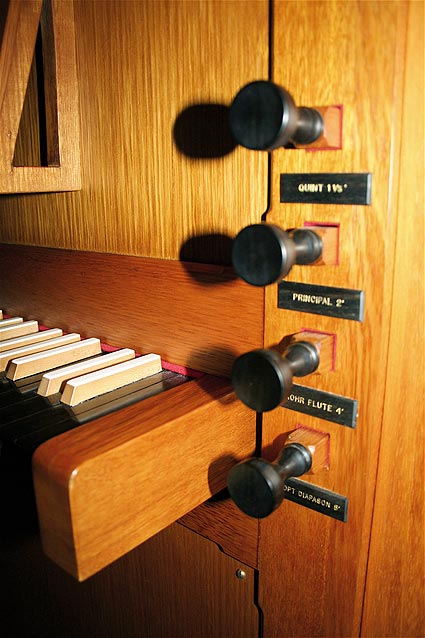
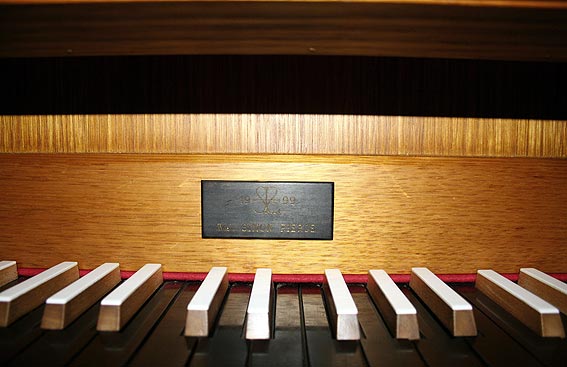
[Photographs by Trevor Bunning (October 2007)]
___________________________________________________________________________
1 Denis W. Martin, The Foundation of the Catholic Church in Queensland (Toowoomba: Church Archivists' Society, 1988), pp. 1, 12-13, 50.
2 Queensland Heritage Council, Queensland Heritage Register, location 600108; Liturgy News, vol. 29, no. 1 (March 1999), p. 10.
3 Brian Andrews, Australian Gothic: The Gothic Revival in Australian Architecture from the 1840s to the 1950s (Carlton South: Melbourne University Press, 2001), pp. 73, 151.
4 Pugh's Queensland Almanac for 1875, s.v. 16 & 17 May, 1874.
5 Liturgy News, vol. 29, no. 1 (March 1999), p. 10.
6 Martin, op. cit., p. 99.
7 The Brisbane Courier (24 January 1873), p. 4; The Freeman's Journal (8 February 1873), p. 6; The Brisbane Courier (16 May 1874), p. 1.
8 Personal communication to W.J. Simon Pierce from David Fincham (undated).
9 The Leader (25 June 1978), p. 15.
10 Personal communication to G. Cox from Veronica Corkeron, 4 July 1988; see also: Organ Society of Queensland Newsletter, vol. 15, no. 2 (October 1987), p. 10.
11 The Organ Voice, vol. 25, no. 2 (June 1999), p. 27.
12 Details supplied by W.J. Simon Pierce, September 2000; Original specification supplied by Veronica Corkeron, 4 July 1988.